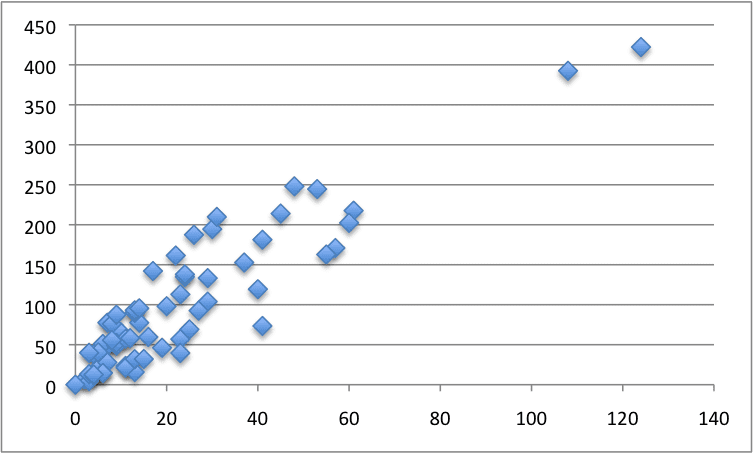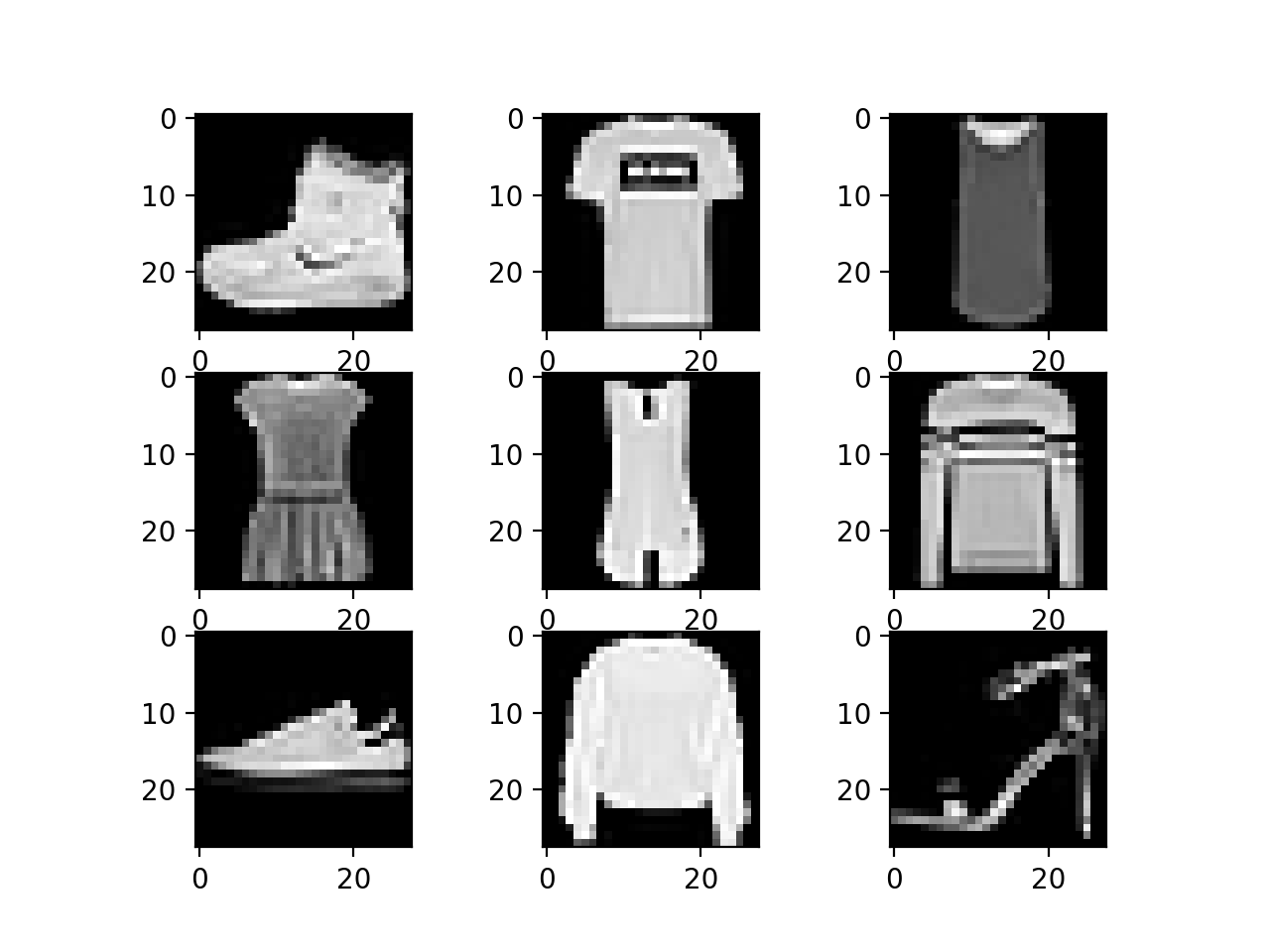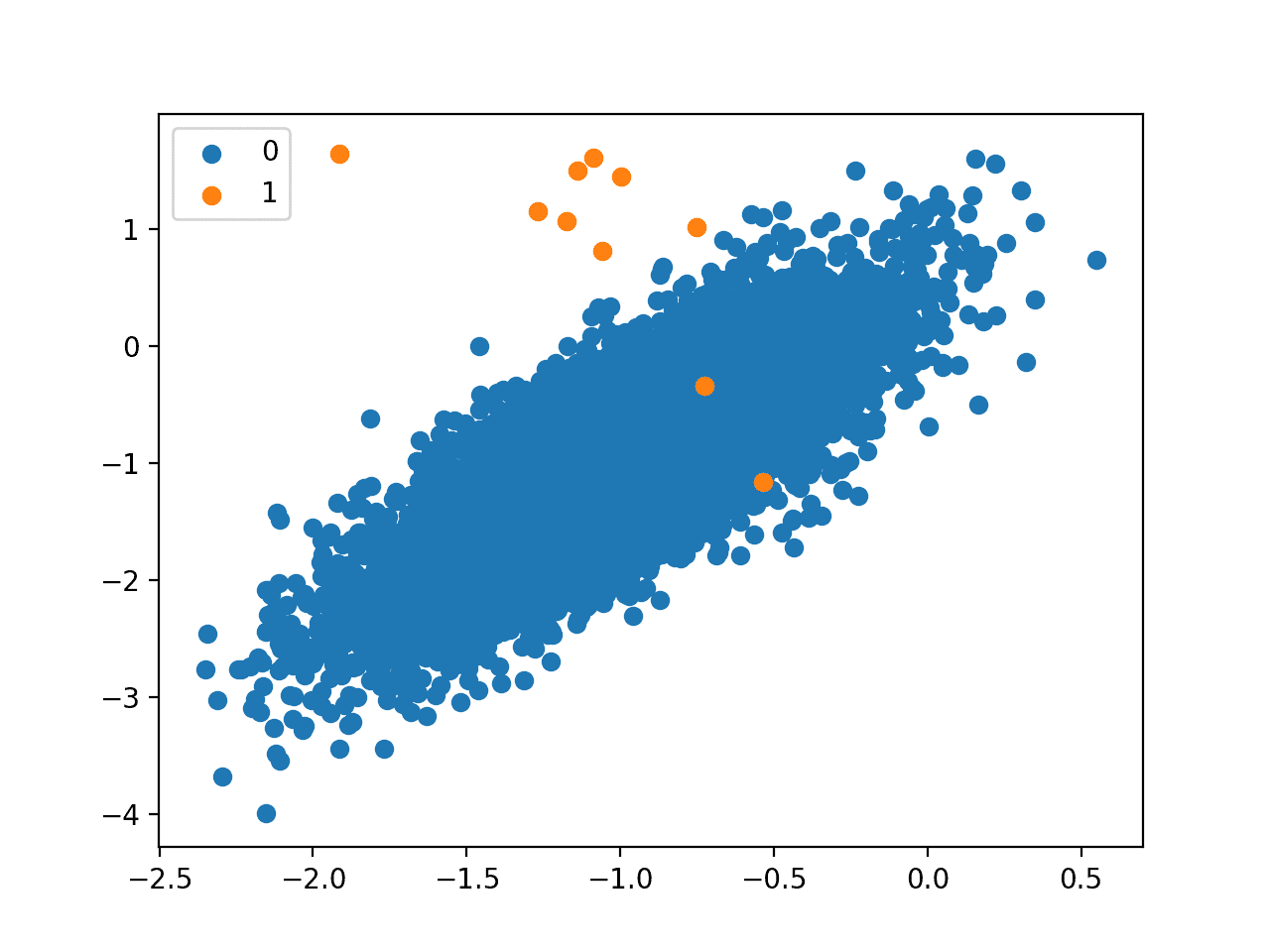An imbalanced classification problem is a problem that involves predicting a class label where the distribution of class labels in the training dataset is skewed.
Many real-world classification problems have an imbalanced class distribution, therefore it is important for machine learning practitioners to get familiar with working with these types of problems.
In this tutorial, you will discover a suite of standard machine learning datasets for imbalanced classification.
After completing this tutorial, you will know:
- Standard machine learning datasets with an imbalance of two classes.
- Standard datasets for multiclass classification with a skewed class distribution.
- Popular imbalanced classification datasets used for machine learning competitions.
Kick-start your project with my new book Imbalanced Classification with Python, including step-by-step tutorials and the Python source code files for all examples.
Let’s get started.
- Updated Jan/2021: Updated links for API documentation.

Standard Machine Learning Datasets for Imbalanced Classification
Photo by Graeme Churchard, some rights reserved.
Tutorial Overview
This tutorial is divided into three parts; they are:
- Binary Classification Datasets
- Multiclass Classification Datasets
- Competition and Other Datasets
Binary Classification Datasets
Binary classification predictive modeling problems are those with two classes.
Typically, imbalanced binary classification problems describe a normal state (class 0) and an abnormal state (class 1), such as fraud, a diagnosis, or a fault.
In this section, we will take a closer look at three standard binary classification machine learning datasets with a class imbalance. These are datasets that are small enough to fit in memory and have been well studied, providing the basis of investigation in many research papers.
The names of these datasets are as follows:
- Pima Indians Diabetes (Pima)
- Haberman Breast Cancer (Haberman)
- German Credit (German)
Each dataset will be loaded and the nature of the class imbalance will be summarized.
Pima Indians Diabetes (Pima)
Each record describes the medical details of a female, and the prediction is the onset of diabetes within the next five years.
- More Details: pima-indians-diabetes.names
- Dataset: pima-indians-diabetes.csv
Below provides a sample of the first five rows of the dataset.
|
1 2 3 4 5 6 |
6,148,72,35,0,33.6,0.627,50,1 1,85,66,29,0,26.6,0.351,31,0 8,183,64,0,0,23.3,0.672,32,1 1,89,66,23,94,28.1,0.167,21,0 0,137,40,35,168,43.1,2.288,33,1 ... |
The example below loads and summarizes the class breakdown of the dataset.
|
1 2 3 4 5 6 7 8 9 10 11 12 13 14 15 16 17 18 19 20 21 22 23 24 25 26 |
# Summarize the Pima Indians Diabetes dataset from numpy import unique from pandas import read_csv # load the dataset url = 'https://raw.githubusercontent.com/jbrownlee/Datasets/master/pima-indians-diabetes.csv' dataframe = read_csv(url, header=None) # get the values values = dataframe.values X, y = values[:, :-1], values[:, -1] # gather details n_rows = X.shape[0] n_cols = X.shape[1] classes = unique(y) n_classes = len(classes) # summarize print('N Examples: %d' % n_rows) print('N Inputs: %d' % n_cols) print('N Classes: %d' % n_classes) print('Classes: %s' % classes) print('Class Breakdown:') # class breakdown breakdown = '' for c in classes: total = len(y[y == c]) ratio = (total / float(len(y))) * 100 print(' - Class %s: %d (%.5f%%)' % (str(c), total, ratio)) |
Running the example provides the following output.
|
1 2 3 4 5 6 7 |
N Examples: 768 N Inputs: 8 N Classes: 2 Classes: [0. 1.] Class Breakdown: - Class 0.0: 500 (65.10417%) - Class 1.0: 268 (34.89583%) |
Want to Get Started With Imbalance Classification?
Take my free 7-day email crash course now (with sample code).
Click to sign-up and also get a free PDF Ebook version of the course.
Haberman Breast Cancer (Haberman)
Each record describes the medical details of a patient and the prediction is whether the patient survived after five years or not.
- More Details: haberman.names
- Dataset: haberman.csv
- Additional Information
Below provides a sample of the first five rows of the dataset.
|
1 2 3 4 5 6 |
30,64,1,1 30,62,3,1 30,65,0,1 31,59,2,1 31,65,4,1 ... |
The example below loads and summarizes the class breakdown of the dataset.
|
1 2 3 4 5 6 7 8 9 10 11 12 13 14 15 16 17 18 19 20 21 22 23 24 25 26 |
# Summarize the Haberman Breast Cancer dataset from numpy import unique from pandas import read_csv # load the dataset url = 'https://raw.githubusercontent.com/jbrownlee/Datasets/master/haberman.csv' dataframe = read_csv(url, header=None) # get the values values = dataframe.values X, y = values[:, :-1], values[:, -1] # gather details n_rows = X.shape[0] n_cols = X.shape[1] classes = unique(y) n_classes = len(classes) # summarize print('N Examples: %d' % n_rows) print('N Inputs: %d' % n_cols) print('N Classes: %d' % n_classes) print('Classes: %s' % classes) print('Class Breakdown:') # class breakdown breakdown = '' for c in classes: total = len(y[y == c]) ratio = (total / float(len(y))) * 100 print(' - Class %s: %d (%.5f%%)' % (str(c), total, ratio)) |
Running the example provides the following output.
|
1 2 3 4 5 6 7 |
N Examples: 306 N Inputs: 3 N Classes: 2 Classes: [1 2] Class Breakdown: - Class 1: 225 (73.52941%) - Class 2: 81 (26.47059%) |
German Credit (German)
Each record describes the financial details of a person and the prediction is whether the person is a good credit risk.
- More Details: german.names
- Dataset: german.csv
- Additional Information
Below provides a sample of the first five rows of the dataset.
|
1 2 3 4 5 6 |
A11,6,A34,A43,1169,A65,A75,4,A93,A101,4,A121,67,A143,A152,2,A173,1,A192,A201,1 A12,48,A32,A43,5951,A61,A73,2,A92,A101,2,A121,22,A143,A152,1,A173,1,A191,A201,2 A14,12,A34,A46,2096,A61,A74,2,A93,A101,3,A121,49,A143,A152,1,A172,2,A191,A201,1 A11,42,A32,A42,7882,A61,A74,2,A93,A103,4,A122,45,A143,A153,1,A173,2,A191,A201,1 A11,24,A33,A40,4870,A61,A73,3,A93,A101,4,A124,53,A143,A153,2,A173,2,A191,A201,2 ... |
The example below loads and summarizes the class breakdown of the dataset.
|
1 2 3 4 5 6 7 8 9 10 11 12 13 14 15 16 17 18 19 20 21 22 23 24 25 26 |
# Summarize the German Credit dataset from numpy import unique from pandas import read_csv # load the dataset url = 'https://raw.githubusercontent.com/jbrownlee/Datasets/master/german.csv' dataframe = read_csv(url, header=None) # get the values values = dataframe.values X, y = values[:, :-1], values[:, -1] # gather details n_rows = X.shape[0] n_cols = X.shape[1] classes = unique(y) n_classes = len(classes) # summarize print('N Examples: %d' % n_rows) print('N Inputs: %d' % n_cols) print('N Classes: %d' % n_classes) print('Classes: %s' % classes) print('Class Breakdown:') # class breakdown breakdown = '' for c in classes: total = len(y[y == c]) ratio = (total / float(len(y))) * 100 print(' - Class %s: %d (%.5f%%)' % (str(c), total, ratio)) |
Running the example provides the following output.
|
1 2 3 4 5 6 7 |
N Examples: 1000 N Inputs: 20 N Classes: 2 Classes: [1 2] Class Breakdown: - Class 1: 700 (70.00000%) - Class 2: 300 (30.00000%) |
Multiclass Classification Datasets
Multiclass classification predictive modeling problems are those with more than two classes.
Typically, imbalanced multiclass classification problems describe multiple different events, some significantly more common than others.
In this section, we will take a closer look at three standard multiclass classification machine learning datasets with a class imbalance. These are datasets that are small enough to fit in memory and have been well studied, providing the basis of investigation in many research papers.
The names of these datasets are as follows:
- Glass Identification (Glass)
- E-coli (Ecoli)
- Thyroid Gland (Thyroid)
Note: it is common in research papers to transform imbalanced multiclass classification problems into imbalanced binary classification problems by grouping all of the majority classes into one class and leaving the smallest minority class.
Each dataset will be loaded and the nature of the class imbalance will be summarized.
Glass Identification (Glass)
Each record describes the chemical content of glass and prediction involves the type of glass.
- More Details: glass.names
- Dataset: glass.csv
- Additional Information
Below provides a sample of the first five rows of the dataset.
|
1 2 3 4 5 6 |
1.52101,13.64,4.49,1.10,71.78,0.06,8.75,0.00,0.00,1 1.51761,13.89,3.60,1.36,72.73,0.48,7.83,0.00,0.00,1 1.51618,13.53,3.55,1.54,72.99,0.39,7.78,0.00,0.00,1 1.51766,13.21,3.69,1.29,72.61,0.57,8.22,0.00,0.00,1 1.51742,13.27,3.62,1.24,73.08,0.55,8.07,0.00,0.00,1 ... |
The first column represents a row identifier and can be removed.
The example below loads and summarizes the class breakdown of the dataset.
|
1 2 3 4 5 6 7 8 9 10 11 12 13 14 15 16 17 18 19 20 21 22 23 24 25 26 |
# Summarize the Glass Identification dataset from numpy import unique from pandas import read_csv # load the dataset url = 'https://raw.githubusercontent.com/jbrownlee/Datasets/master/glass.csv' dataframe = read_csv(url, header=None) # get the values values = dataframe.values X, y = values[:, :-1], values[:, -1] # gather details n_rows = X.shape[0] n_cols = X.shape[1] classes = unique(y) n_classes = len(classes) # summarize print('N Examples: %d' % n_rows) print('N Inputs: %d' % n_cols) print('N Classes: %d' % n_classes) print('Classes: %s' % classes) print('Class Breakdown:') # class breakdown breakdown = '' for c in classes: total = len(y[y == c]) ratio = (total / float(len(y))) * 100 print(' - Class %s: %d (%.5f%%)' % (str(c), total, ratio)) |
Running the example provides the following output.
|
1 2 3 4 5 6 7 8 9 10 11 |
N Examples: 214 N Inputs: 9 N Classes: 6 Classes: [1. 2. 3. 5. 6. 7.] Class Breakdown: - Class 1.0: 70 (32.71028%) - Class 2.0: 76 (35.51402%) - Class 3.0: 17 (7.94393%) - Class 5.0: 13 (6.07477%) - Class 6.0: 9 (4.20561%) - Class 7.0: 29 (13.55140%) |
E-coli (Ecoli)
Each record describes the result of different tests and prediction involves the protein localization site name.
- More Details: ecoli.names
- Dataset: ecoli.csv
- Additional Information
Below provides a sample of the first five rows of the dataset.
|
1 2 3 4 5 6 |
0.49,0.29,0.48,0.50,0.56,0.24,0.35,cp 0.07,0.40,0.48,0.50,0.54,0.35,0.44,cp 0.56,0.40,0.48,0.50,0.49,0.37,0.46,cp 0.59,0.49,0.48,0.50,0.52,0.45,0.36,cp 0.23,0.32,0.48,0.50,0.55,0.25,0.35,cp ... |
The first column represents a row identifier or name and can be removed.
The example below loads and summarizes the class breakdown of the dataset.
|
1 2 3 4 5 6 7 8 9 10 11 12 13 14 15 16 17 18 19 20 21 22 23 24 25 26 |
# Summarize the Ecoli dataset from numpy import unique from pandas import read_csv # load the dataset url = 'https://raw.githubusercontent.com/jbrownlee/Datasets/master/ecoli.csv' dataframe = read_csv(url, header=None) # get the values values = dataframe.values X, y = values[:, :-1], values[:, -1] # gather details n_rows = X.shape[0] n_cols = X.shape[1] classes = unique(y) n_classes = len(classes) # summarize print('N Examples: %d' % n_rows) print('N Inputs: %d' % n_cols) print('N Classes: %d' % n_classes) print('Classes: %s' % classes) print('Class Breakdown:') # class breakdown breakdown = '' for c in classes: total = len(y[y == c]) ratio = (total / float(len(y))) * 100 print(' - Class %s: %d (%.5f%%)' % (str(c), total, ratio)) |
Running the example provides the following output.
|
1 2 3 4 5 6 7 8 9 10 11 12 13 |
N Examples: 336 N Inputs: 7 N Classes: 8 Classes: ['cp' 'im' 'imL' 'imS' 'imU' 'om' 'omL' 'pp'] Class Breakdown: - Class cp: 143 (42.55952%) - Class im: 77 (22.91667%) - Class imL: 2 (0.59524%) - Class imS: 2 (0.59524%) - Class imU: 35 (10.41667%) - Class om: 20 (5.95238%) - Class omL: 5 (1.48810%) - Class pp: 52 (15.47619%) |
Thyroid Gland (Thyroid)
Each record describes the result of different tests on a thyroid and prediction involves the medical diagnosis of the thyroid.
- More Details: new-thyroid.names
- Dataset: new-thyroid.csv
- Additional Information
Below provides a sample of the first five rows of the dataset.
|
1 2 3 4 5 6 |
107,10.1,2.2,0.9,2.7,1 113,9.9,3.1,2.0,5.9,1 127,12.9,2.4,1.4,0.6,1 109,5.3,1.6,1.4,1.5,1 105,7.3,1.5,1.5,-0.1,1 ... |
The example below loads and summarizes the class breakdown of the dataset.
|
1 2 3 4 5 6 7 8 9 10 11 12 13 14 15 16 17 18 19 20 21 22 23 24 25 26 |
# Summarize the Thyroid Gland dataset from numpy import unique from pandas import read_csv # load the dataset url = 'https://raw.githubusercontent.com/jbrownlee/Datasets/master/new-thyroid.csv' dataframe = read_csv(url, header=None) # get the values values = dataframe.values X, y = values[:, :-1], values[:, -1] # gather details n_rows = X.shape[0] n_cols = X.shape[1] classes = unique(y) n_classes = len(classes) # summarize print('N Examples: %d' % n_rows) print('N Inputs: %d' % n_cols) print('N Classes: %d' % n_classes) print('Classes: %s' % classes) print('Class Breakdown:') # class breakdown breakdown = '' for c in classes: total = len(y[y == c]) ratio = (total / float(len(y))) * 100 print(' - Class %s: %d (%.5f%%)' % (str(c), total, ratio)) |
Running the example provides the following output.
|
1 2 3 4 5 6 7 8 |
N Examples: 215 N Inputs: 5 N Classes: 3 Classes: [1. 2. 3.] Class Breakdown: - Class 1.0: 150 (69.76744%) - Class 2.0: 35 (16.27907%) - Class 3.0: 30 (13.95349%) |
Competition and Other Datasets
This section lists additional datasets used in research papers that are less used, larger, or datasets used as the basis of machine learning competitions.
The names of these datasets are as follows:
- Credit Card Fraud (Credit)
- Porto Seguro Auto Insurance Claim (Porto Seguro)
Each dataset will be loaded and the nature of the class imbalance will be summarized.
Credit Card Fraud (Credit)
Each record describes a credit card translation and it is classified as fraud.
This data is about 144 megabytes uncompressed or 66 megabytes compressed.
- Download: creditcardfraud.zip
- Additional Information
Download the dataset and unzip it into your current working directory.
Below provides a sample of the first five rows of the dataset.
|
1 2 3 4 5 6 |
"Time","V1","V2","V3","V4","V5","V6","V7","V8","V9","V10","V11","V12","V13","V14","V15","V16","V17","V18","V19","V20","V21","V22","V23","V24","V25","V26","V27","V28","Amount","Class" 0,-1.3598071336738,-0.0727811733098497,2.53634673796914,1.37815522427443,-0.338320769942518,0.462387777762292,0.239598554061257,0.0986979012610507,0.363786969611213,0.0907941719789316,-0.551599533260813,-0.617800855762348,-0.991389847235408,-0.311169353699879,1.46817697209427,-0.470400525259478,0.207971241929242,0.0257905801985591,0.403992960255733,0.251412098239705,-0.018306777944153,0.277837575558899,-0.110473910188767,0.0669280749146731,0.128539358273528,-0.189114843888824,0.133558376740387,-0.0210530534538215,149.62,"0" 0,1.19185711131486,0.26615071205963,0.16648011335321,0.448154078460911,0.0600176492822243,-0.0823608088155687,-0.0788029833323113,0.0851016549148104,-0.255425128109186,-0.166974414004614,1.61272666105479,1.06523531137287,0.48909501589608,-0.143772296441519,0.635558093258208,0.463917041022171,-0.114804663102346,-0.183361270123994,-0.145783041325259,-0.0690831352230203,-0.225775248033138,-0.638671952771851,0.101288021253234,-0.339846475529127,0.167170404418143,0.125894532368176,-0.00898309914322813,0.0147241691924927,2.69,"0" 1,-1.35835406159823,-1.34016307473609,1.77320934263119,0.379779593034328,-0.503198133318193,1.80049938079263,0.791460956450422,0.247675786588991,-1.51465432260583,0.207642865216696,0.624501459424895,0.066083685268831,0.717292731410831,-0.165945922763554,2.34586494901581,-2.89008319444231,1.10996937869599,-0.121359313195888,-2.26185709530414,0.524979725224404,0.247998153469754,0.771679401917229,0.909412262347719,-0.689280956490685,-0.327641833735251,-0.139096571514147,-0.0553527940384261,-0.0597518405929204,378.66,"0" 1,-0.966271711572087,-0.185226008082898,1.79299333957872,-0.863291275036453,-0.0103088796030823,1.24720316752486,0.23760893977178,0.377435874652262,-1.38702406270197,-0.0549519224713749,-0.226487263835401,0.178228225877303,0.507756869957169,-0.28792374549456,-0.631418117709045,-1.0596472454325,-0.684092786345479,1.96577500349538,-1.2326219700892,-0.208037781160366,-0.108300452035545,0.00527359678253453,-0.190320518742841,-1.17557533186321,0.647376034602038,-0.221928844458407,0.0627228487293033,0.0614576285006353,123.5,"0" ... |
The example below loads and summarizes the class breakdown of the dataset.
|
1 2 3 4 5 6 7 8 9 10 11 12 13 14 15 16 17 18 19 20 21 22 23 24 25 |
# Summarize the Credit Card Fraud dataset from numpy import unique from pandas import read_csv # load the dataset dataframe = read_csv('creditcard.csv') # get the values values = dataframe.values X, y = values[:, :-1], values[:, -1] # gather details n_rows = X.shape[0] n_cols = X.shape[1] classes = unique(y) n_classes = len(classes) # summarize print('N Examples: %d' % n_rows) print('N Inputs: %d' % n_cols) print('N Classes: %d' % n_classes) print('Classes: %s' % classes) print('Class Breakdown:') # class breakdown breakdown = '' for c in classes: total = len(y[y == c]) ratio = (total / float(len(y))) * 100 print(' - Class %s: %d (%.5f%%)' % (str(c), total, ratio)) |
Running the example provides the following output.
|
1 2 3 4 5 6 7 |
N Examples: 284807 N Inputs: 30 N Classes: 2 Classes: [0. 1.] Class Breakdown: - Class 0.0: 284315 (99.82725%) - Class 1.0: 492 (0.17275%) |
Porto Seguro Auto Insurance Claim (Porto Seguro)
Each record describes people’s car insurance details and prediction involves whether or not the person will make an insurance claim.
This data is about 42 megabytes compressed.
Download the dataset and unzip it into your current working directory.
Below provides a sample of the first five rows of the dataset.
|
1 2 3 4 5 6 |
id,target,ps_ind_01,ps_ind_02_cat,ps_ind_03,ps_ind_04_cat,ps_ind_05_cat,ps_ind_06_bin,ps_ind_07_bin,ps_ind_08_bin,ps_ind_09_bin,ps_ind_10_bin,ps_ind_11_bin,ps_ind_12_bin,ps_ind_13_bin,ps_ind_14,ps_ind_15,ps_ind_16_bin,ps_ind_17_bin,ps_ind_18_bin,ps_reg_01,ps_reg_02,ps_reg_03,ps_car_01_cat,ps_car_02_cat,ps_car_03_cat,ps_car_04_cat,ps_car_05_cat,ps_car_06_cat,ps_car_07_cat,ps_car_08_cat,ps_car_09_cat,ps_car_10_cat,ps_car_11_cat,ps_car_11,ps_car_12,ps_car_13,ps_car_14,ps_car_15,ps_calc_01,ps_calc_02,ps_calc_03,ps_calc_04,ps_calc_05,ps_calc_06,ps_calc_07,ps_calc_08,ps_calc_09,ps_calc_10,ps_calc_11,ps_calc_12,ps_calc_13,ps_calc_14,ps_calc_15_bin,ps_calc_16_bin,ps_calc_17_bin,ps_calc_18_bin,ps_calc_19_bin,ps_calc_20_bin 7,0,2,2,5,1,0,0,1,0,0,0,0,0,0,0,11,0,1,0,0.7,0.2,0.7180703307999999,10,1,-1,0,1,4,1,0,0,1,12,2,0.4,0.8836789178,0.3708099244,3.6055512755000003,0.6,0.5,0.2,3,1,10,1,10,1,5,9,1,5,8,0,1,1,0,0,1 9,0,1,1,7,0,0,0,0,1,0,0,0,0,0,0,3,0,0,1,0.8,0.4,0.7660776723,11,1,-1,0,-1,11,1,1,2,1,19,3,0.316227766,0.6188165191,0.3887158345,2.4494897428,0.3,0.1,0.3,2,1,9,5,8,1,7,3,1,1,9,0,1,1,0,1,0 13,0,5,4,9,1,0,0,0,1,0,0,0,0,0,0,12,1,0,0,0.0,0.0,-1.0,7,1,-1,0,-1,14,1,1,2,1,60,1,0.316227766,0.6415857163,0.34727510710000004,3.3166247904,0.5,0.7,0.1,2,2,9,1,8,2,7,4,2,7,7,0,1,1,0,1,0 16,0,0,1,2,0,0,1,0,0,0,0,0,0,0,0,8,1,0,0,0.9,0.2,0.5809475019,7,1,0,0,1,11,1,1,3,1,104,1,0.3741657387,0.5429487899000001,0.2949576241,2.0,0.6,0.9,0.1,2,4,7,1,8,4,2,2,2,4,9,0,0,0,0,0,0 ... |
The example below loads and summarizes the class breakdown of the dataset.
|
1 2 3 4 5 6 7 8 9 10 11 12 13 14 15 16 17 18 19 20 21 22 23 24 25 |
# Summarize the Porto Seguro’s Safe Driver Prediction dataset from numpy import unique from pandas import read_csv # load the dataset dataframe = read_csv('train.csv') # get the values values = dataframe.values X, y = values[:, :-1], values[:, -1] # gather details n_rows = X.shape[0] n_cols = X.shape[1] classes = unique(y) n_classes = len(classes) # summarize print('N Examples: %d' % n_rows) print('N Inputs: %d' % n_cols) print('N Classes: %d' % n_classes) print('Classes: %s' % classes) print('Class Breakdown:') # class breakdown breakdown = '' for c in classes: total = len(y[y == c]) ratio = (total / float(len(y))) * 100 print(' - Class %s: %d (%.5f%%)' % (str(c), total, ratio)) |
Running the example provides the following output.
|
1 2 3 4 5 6 7 |
N Examples: 595212 N Inputs: 58 N Classes: 2 Classes: [0. 1.] Class Breakdown: - Class 0.0: 503955 (84.66815%) - Class 1.0: 91257 (15.33185%) |
Further Reading
This section provides more resources on the topic if you are looking to go deeper.
Papers
- A Study of the Behavior of Several Methods for Balancing Machine Learning Training Data, 2004.
- A Review on Ensembles for the Class Imbalance Problem: Bagging-, Boosting-, and Hybrid-Based Approaches, 2011.
Articles
Summary
In this tutorial, you discovered a suite of standard machine learning datasets for imbalanced classification.
Specifically, you learned:
- Standard machine learning datasets with an imbalance of two classes.
- Standard datasets for multiclass classification with a skewed class distribution.
- Popular imbalanced classification datasets used for machine learning competitions.
Do you have any questions?
Ask your questions in the comments below and I will do my best to answer.








Very useful information sir I am a researcher and my area is colon cancer detection I require the colon cancer data set sir
Thanks.
This might help:
https://machinelearningmastery.com/faq/single-faq/where-can-i-get-a-dataset-on-___
Should we always resampling the imbalanced class?
No, try a suite of methods and use the the method/s that meet the goals of the project and give the best results.
great post jason. i love your blog keep posting like this
Thanks!
Where do you teach how to deal with imbalanced data sets(for example the technique – SMOTE)
I will be sharing tutorials on this topic in the coming weeks.
Very beneficial post.
thanks
You’re welcome.
Hello Mr. Jason, your post was so informative and helpful. Thank you for posting it. I am having a dataset of money laundering. I have to build a classification model. Since I am a student and new to machine learning, it’s not getting done. Anything that could guide me ?
Perhaps follow this process:
https://machinelearningmastery.com/start-here/#process
Dear Dr Jason,
In relation to the zip file “creditcardfraud.zip” located https://raw.githubusercontent.com/jbrownlee/Datasets/master/creditcardfraud.zip , it does not exist.
Can you suggest any other place to download it please.
Thank you
Anthony of Sydney
Thanks, I have updated the link to:
https://github.com/jbrownlee/Datasets/blob/master/creditcard.csv.zip